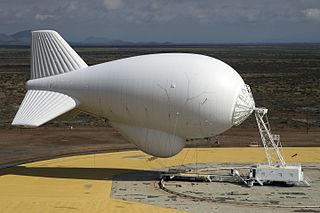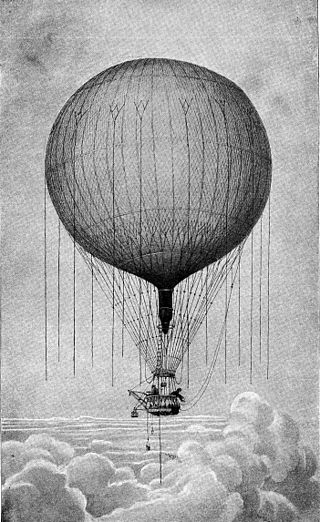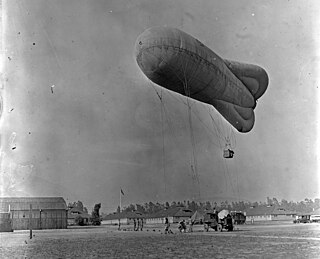
| relations = | laterwork = | signature = Ferdinand von Zeppelin signature.svg | website = | signature_size = | signature_alt =
Luftschiffertruppe, a German word meaning "airshipmen's troop", was the designation of the German airship units.

An aerostat or lighter-than-air aircraft is an aircraft that relies on buoyancy to maintain flight. Aerostats include the unpowered balloons and the powered airships.
This is a list of aviation-related events during the 19th century :

The Deutsche Luftstreitkräfte – known before October 1916 as Die Fliegertruppen des deutschen Kaiserreiches – was the air arm of the Imperial German Army. In English-language sources it is usually referred to as the Imperial German Air Service, although that is not a literal translation of either name. German naval aviators of the Marine-Fliegerabteilung were an integral part of the Imperial German Navy. Both military branches operated aeroplanes, observation balloons and airships.

August von Parseval was a German airship designer. His designs for an amphibian flying boat, balanced by two wing-floats, achieved liftoff in April 1910. This makred the beginning of marine aviation in Germany. He became a professor at the Technical University of Berlin.

An observation balloon is a type of balloon that is employed as an aerial platform for gathering intelligence and spotting artillery. The use of observation balloons began during the French Revolutionary Wars, reaching their zenith during World War I, and they continue in limited use today. Synonyms include espionage balloon, reconnaissance balloon, spy balloon, and surveillance balloon.

A kite balloon is a tethered balloon which is shaped to help make it stable in low and moderate winds and to increase its lift. It typically comprises a streamlined envelope with stabilising features and a harness or yoke connecting it to the main tether and a second harness connected to an observer's basket.

The D class blimp was a patrol airship used by the US Navy in the early 1920s. The D-type blimps were slightly larger than the C-type and had many detail improvements. The Navy continued the practice of dividing the envelope production between Goodyear and Goodrich. The control cars were manufactured by the Naval Aircraft Factory. The major improvements over the C-type blimps were a better control car design and easier, more reliable controls and instrumentation. The engines were moved to the rear to reduce noise and allow easier communications between crew members. The fuel tanks were suspended from the sides of the envelope. The envelope was identical to the C-type, except an additional six-foot panel was inserted for a total length of 198 feet (60 m) and a volume of 190,000 cubic feet (5,400 m3). The last of the D-Class, D-6, had a redesigned control car by Leroy Grumman who later founded the Grumman Aircraft Engineering Corporation.

The H class blimp was an observation airship built for the U.S. Navy in the early 1920s. The original "H" Class design of 1919 was for a twin engined airship of approximately 80,000 cubic feet volume. Commander Lewis Maxfield suggested that a small airship which could be used either as a tethered kite balloon, or be towed by a ship until releasing its cable, would be able to scout on its own. The concept was an airship similar to the later Army Motorized Kite Balloons.

A semi-rigid airship is an airship which has a stiff keel or truss supporting the main envelope along its length. The keel may be partially flexible or articulated and may be located inside or outside the main envelope. The outer shape of the airship is maintained by gas pressure, as with the non-rigid "blimp". Semi-rigid dirigibles were built in significant quantity from the late 19th century but in the late 1930s they fell out of favour along with rigid airships. No more were constructed until the semi-rigid design was revived by the Zeppelin NT in 1997.

The ZeppelinLZ 1 was the first successful experimental rigid airship. It was first flown from a floating hangar on Lake Constance, near Friedrichshafen in southern Germany, on 2 July 1900. "LZ" stood for Luftschiff Zeppelin, or "Airship Zeppelin".

Richard Assmann was a German meteorologist and physician who was a native of Magdeburg. He made numerous contributions in high altitude research of the Earth's atmosphere. He was a pioneer of scientific aeronautics and considered a co-founder of aerology.
August Riedinger was a German businessman who operated gas companies in Germany and Europe and also participated in balloon and airship manufacturing.
Founded on August 31, 1881, the Deutsche Verein zur Förderung der Luftschifffahrt,, was the first German aviation association.

A kytoon or kite balloon is a tethered aircraft which obtains some of its lift dynamically as a heavier-than-air kite and the rest aerostatically as a lighter-than-air balloon. The word is a portmanteau of kite and balloon.

The Berlin scientific balloon flights were a series of 65 manned and 29 unmanned balloon flights carried out between 1888 and 1899 by the German Society for the Promotion of Aeronautics to investigate the atmosphere above the planetary boundary layer. The flights were organized by Richard Aßmann, Professor at the Meteorological Institute of Berlin, who also developed the most important of the measurement instruments employed by them. The execution lay primarily in the hands of the military airship pilot Hans Groß and the meteorologist Arthur Berson. In 1894, Berson flew with the balloon Phönix to a height of 9155 meters, the highest that any human had flown until then.

M.III Körting was a non-rigid military single-gondola airship built in 1911 by the Österreichische Maschinenbau-AG Körting in Vienna, designed by engineers Cassinone, Strattmann and Basenach. The ship was built for the aviatic troops of the Austro-Hungarian Army, conducting radiotelegraphic and photogrammetric research. During military practice on 20 June 1914 near Fischamend, M.III collided with a Farman F.20 military biplane and crashed.

Caquot kite balloon was a type of non-rigid military observation balloon, designed in 1915 by Albert Caquot. The type became widely used by Allied forces in World War I warfare for multiple observation or naval defence uses and later also as a anti-aircraft barrage balloon.




















